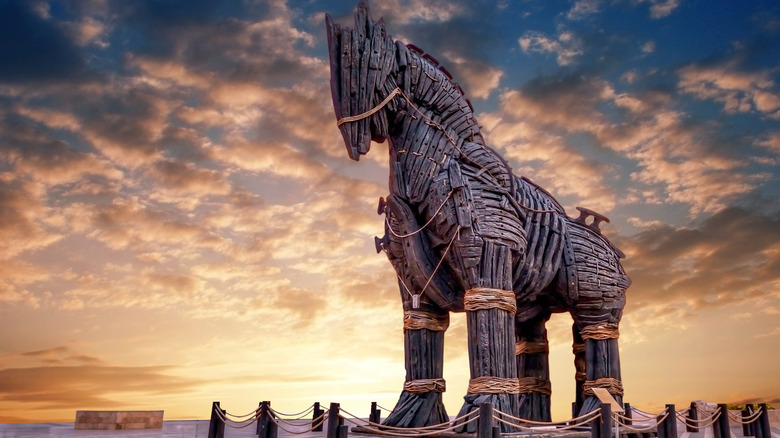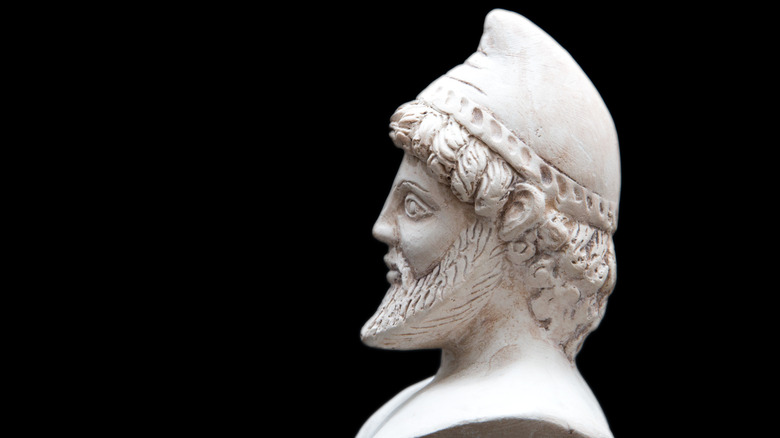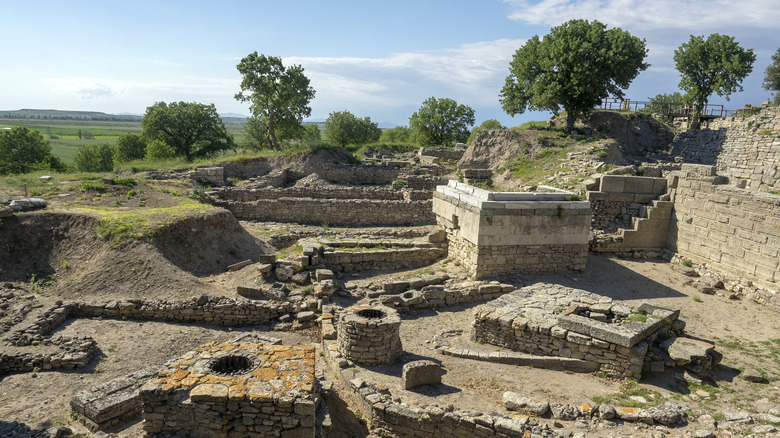Why The Trojan Horse Might Not Have Been A Horse
People may not always know the story behind the term "Trojan horse," but we all know, more or less, what somebody means when they say it. In modern-day business, it means what a marketer might give to attract customers so they can convince that customer to take a different action. And if you've ever been the victim of malware, you've fallen for a "Trojan horse" — or more commonly a "Trojan" — that got you to click on something that allows your computer to be invaded by viruses, possibly compromising your personal information along the way. The point is clear: a Trojan Horse is exposing weakness from the inside by way of deception.
Now, about that origin story: according to Greek mythology, the Trojan War had been going on for a decade in the 12th or 13th century BC. It was a war against the city of Troy (located in modern-day Turkey) after Paris of Troy took Helen, the most beautiful woman in the world, from her husband Menelaus, the king of Sparta. Over those 10 years, scores of people died, including heroes on both sides — the Greek Achilles and Ajax, and the Trojans Hector and Paris. Still, the Greeks could not defeat the Trojans because the city walls were too great to infiltrate. But the Trojan War finally came to an end when Odysseus, the legendary Greek king of Ithaca (and, yes, the hero of Homer's epic poem, "Odyssey"), hatched a plan that involved a bit of trickery.
The Trojan Horse plan
The Greeks played on the Trojans' sense of spirituality by building a massive, hollow wooden horse, which was made of wood from Cornel trees. The Trojans considered both horses and the Cornel trees to be sacred. In the dark of night, Odysseus and some of his men would climb inside the horse. The rest of the men wheeled the horse to the front gate of Troy and when daylight came, they pretended to load up their boats and leave the area. At first, the Trojans were confused and spent some time discussing whether or not the Greeks could be trusted. Eventually, the Trojans dragged the giant horse inside the city and spent the night celebrating the end of the war. It was all going to Odysseus' plan.
The celebration petered out later that night and by the time most of Troy was sleeping, Odysseus signaled to the Greek fleet to silently return to the city. He then led his men out of the wooden horse to kill the guards, who were, unsurprisingly, caught unawares. The Greeks opened the gates to the city, letting in the rest of Odysseus' men. It took days, but the Greeks slaughtered the Trojans with the exception of some of the women and children they kept or sold as slaves. Temples were destroyed and much of the city was set on fire. After dividing the spoils, some of the Greeks returned home while others traveled further and formed settlements in the area.
Was the Trojan Horse real?
If any of this epic seems too fantastical to be true, it might be because it is. After thousands of years, archaeologists began getting to the bottom of the mystery surrounding the city of Troy (above). And what they've learned is that Troy absolutely did exist. But the so-called Trojan Horse most certainly did not. Some scholars account for the Trojan Horse as pure myth, while others say it's a misunderstanding of either translation or metaphor. According to Hurriyet Daily News, Italian naval archaeologist Francesco Tiboni has argued that the Trojan Horse was actually a boat, but was repeated throughout history as a horse thanks to a problem in translation from ancient Greek.
Another popular explanation for the misunderstanding is that the so-called Trojan Horse was actually a battering ram that was covered in horse skins. "Archaeological evidence shows that Troy was indeed burned down; but the wooden horse is an imaginative fable, perhaps inspired by the way ancient siege-engines were clothed with damp horse-hides to stop them being set alight," said Dr. Armand D'Angour, a classicist at Oxford University (via Oxford University). However, some archaeologists haven't given up hope just yet. In 2021, a team of scholars found dozens of wooden planks at Troy that they say will prove the Trojan Horse was real and a matter of history, not mythology.


